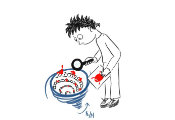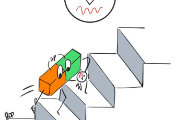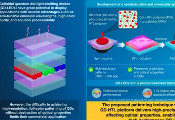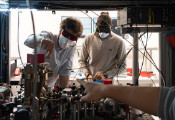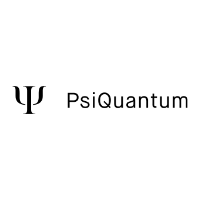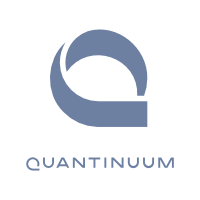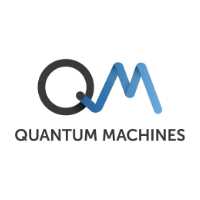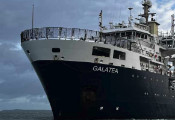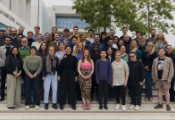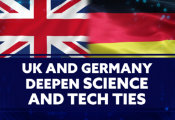Common Crystal Proves Ideal for Low-Temperature Light Technology
October 22, 2025 -- Superconductivity and quantum computing are two fields that have seeped from theoretical circles into popular consciousness. The 2025 Nobel Prize in physics was awarded for work in superconducting quantum circuits that could drive ultra-powerful computers. But what may be less well known is that these promising technologies are often possible only at cryogenic temperatures – near absolute zero. Unfortunately, few materials can handle such extremes. Their cherished physical properties disappear when the chill is on.
In a new paper published in Science, however, a team of engineers at Stanford University spotlights a promising material – strontium titanate, or STO for short – where the optical and mechanical characteristics do not decline at extreme low temperatures, but actually get significantly better, outperforming existing materials by a wide margin. They believe these findings suggest that STO could become the building block for new light-based and mechanical cryogenic devices that push quantum computing, space exploration, and other fields to the next level.
Strontium titanate has electro-optic effects 40 times stronger than the most-used electro-optic material today. But it also works at cryogenic temperatures, which is beneficial for building quantum transducers and switches that are current bottlenecks in quantum technologies,” explained the study’s senior author Jelena Vuckovic, a professor of electrical engineering.
Peak performance
STO’s photonic effects are described as “non-linear.” That is, when an electric field is applied, STO changes its optical and mechanical properties significantly. The optical nonlinearity (the electro-optic effect) in STO can be used to change the frequency, phase, intensity, and the bending of light in ways and to degrees other materials cannot. Engineers can harness these effects to create new low-temperature devices not possible otherwise.
STO is also piezoelectric, meaning it expands and contracts physically when an electric field is applied, opening the possibility of new electromechanical devices that operate at cryogenic temperatures, as well. The researchers noted these observations could make STO particularly valuable in the cold expanses of outer space or in the cryogenic fuel tanks of rockets.
“At low temperature, not only is strontium titanate the most electrically tunable optical material we know of, but it’s also the most piezoelectrically tunable material, emphasized co-first author Christopher Anderson, a former postdoctoral scholar in Vuckovic’s lab who is now on faculty at the University of Illinois, Urbana-Champaign.
Wallflower at the dance
STO is not new. It has been well studied for decades, but never in the context of cryogenic, electrically controlled optics. “STO is not particularly special. It’s not rare. It's not expensive,” says co-first author Giovanni Scuri, a postdoctoral scholar in Vuckovic’s lab. “In fact, it has been often used as a diamond substitute in jewelry or as a growth substrate for other, more valuable materials. Despite being a ‘textbook’ material studied for decades, it performs exceptionally in a cryogenic context.”
Choosing STO did not result from an exhaustive search of potential candidates, but neither was it an accident, Anderson explained. “We knew what ingredients we needed to make a highly tunable material. We found that those ingredients already existed in nature, and we simply used them in a new recipe. STO was the obvious choice,” he said. “When we tried it, surprisingly, it matched our expectations perfectly.”
From there, the team developed an understanding of how to optimize materials for different operating conditions, Scuri said, adding: “The ideas we presented can also be applied to discover other nonlinear materials at any desired regime, or to improve the performance of existing ones.”
The researchers were caught off guard by STO’s performance. In lab tests conducted at 5 degrees Kelvin (-450 F), they noted non-linearities that were some 20 times greater than the best-known nonlinear optical material, lithium niobate, and almost triple that of the previously best-performing cryogenic material, barium titanate. In further experiments, the researchers used their knowledge of what ingredients are desired for optimal performance to substitute oxygen isotopes into the crystal. This nudged STO toward a key threshold known as quantum criticality, with results that were even greater still.
“By adding just two neutrons to exactly 33 percent of the oxygen atoms in the material, the resulting tunability increased by a factor of four,” Anderson noted. “We precisely tuned our recipe to get the best possible performance.”
Next steps
STO has other practical attributes that should be attractive to engineers, the team said. It can be synthesized. It can be modified structurally to fine-tune its properties, as with the oxygen isotopes. And it can be processed using conventional fabrication equipment, all at the wafer scale. All these characteristics suggest great potential for wider adoption of STO in cryogenic quantum applications, such as switches for lasers that allow quantum computers to transmit or manipulate data.
Vuckovic noted that the study was funded in part by industry – Samsung and the quantum computing team at Google, who are searching for just such new materials for devices to propel their efforts. She and the team are now turning their sights to realizing new cryogenic devices based on strontium titanate.
“We found this material on the shelf. We used it and it was amazing. We understood why it was good. Then – the cherry on the top – we knew how to do better, added that special sauce, and we made the world’s best material for these applications,” Anderson said. “It’s a great story.”
In addition to the funding provided by Samsung Electronics and Google, the study was supported by a Vannevar Bush Faculty Fellowship from the U.S. Department of Defense, and by the Department of Energy under the Q-NEXT program.
Additional authors include Aaron Chan and Lu Li at the University of Michigan; Sungjun Eun, Alexander D. White, Geun Ho Ahn, Amir Safavi-Naeini, and Kasper Van Gasse at the E. L. Ginzton Laboratory, Stanford University; and Christine Jilly at Stanford Nano Shared Facilities.

